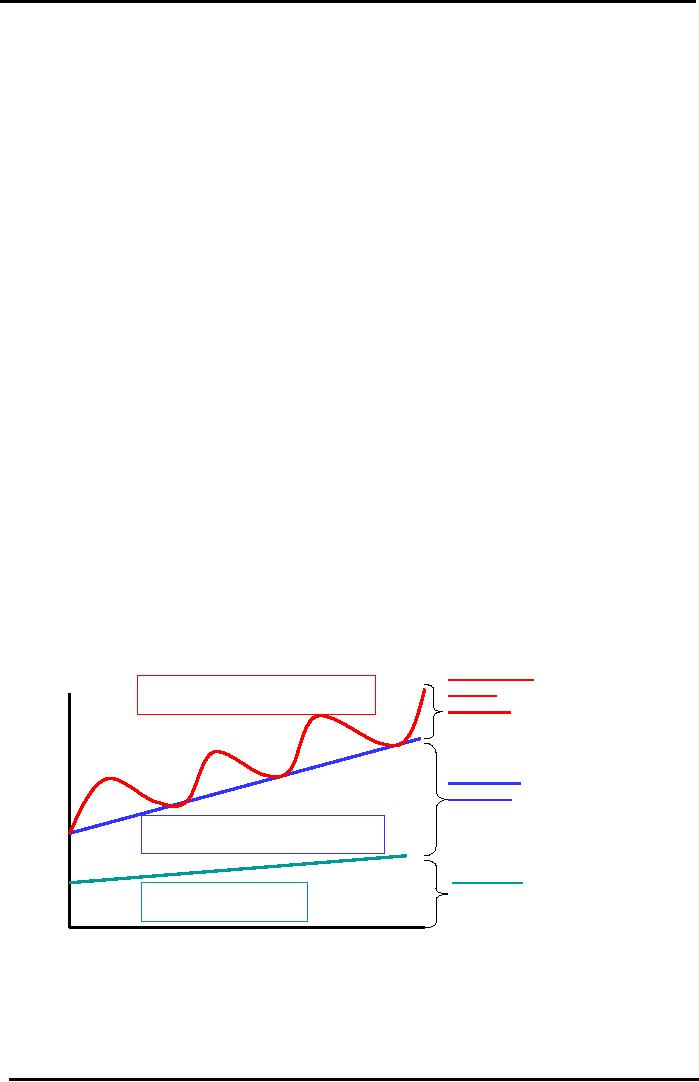 |

Financial
Management MGT201
VU
Lesson
40
CASH
MANAGEMENT AND WORKING CAPITAL
FINANCING
Learning
Objectives:
After
going through this lecture,
you would be able to have an
understanding of the following
topics:
�
Cash
Management &
�
Working
Capital Financing
Cash
Dividend Payout Decision:
�
Link between Dividend Policy &
Cash Management Cash
Dividends are paid out of
Cash!
�
Cash is an idle asset
that do not generate any
return for the company
�
How should firm decide to
pay Cash Dividend based on
Its Impact on Share Price and
Firm's
Value?
�
Gordon's
Formula:
Dividend
policy issue of the company can be
seen through Gordon's
Formula.
Po (Share Price) = DIV1 / (rE
g)
=
EPS x (DIV1/EPS) / (rE
(Pb x ROE)).
DIV1
= Forecasted dividend in the next
year
rE =
Required rate of return on
equity
g
= Growth rate in dividends
Pb =
Plough back ratio
The
two criteria that can
help to decide about dividend
are ROE and rE.
�
ROE is financial accounting measure
of the firm's ability to internally
generate a return. rE
is
the return that the firm's
shareholders REQUIRE. Firms
try to keep ROE HIGHER
than
rE.
�
If ROE < rE then
firm is not generating
enough return to meet shareholder
requirements so it
is
better to payout the dividend.
Lower ROE means company is not
finding sufficient
projects
to generate enough return
higher than rate of return on
equity.
�
If firm makes Dividend
payout, in this case, share
price Po (and Firm Value)
will RISE as
dividend
announcement has positive impact on
company's share
price.
�
If ROE > rE then
firm is better off to Plough
the Retained Earnings back into the
business
and
investing in Positive NPV
Projects or the Firm's core
business. In this case,
company
is
generating higher return
than the return shareholders
require, so the best use of
internally
generated
retained earnings is to use them as a
cheap source of capital or
financing.
�
In this case of ROE > rE if
firm makes Dividend payout,
share price (and Firm
Value) Po
will
FALL. Here it makes sense
for the company to keep cash and
invest it in investments
as
company is generating positive higher
returns on its projects rather than
paying dividend.
�
If ROE = rE then
dividend payment has no
impact on share price of the
company.
Inventory
Management:
In
the last lecture we studied working
capital and cash management in
detail. Now we discuss
inventory
management,
another part of working
capital.
�
3
Types of Inventories: Raw
Material, Work in Process,
Finished Goods
�
Issues
to Consider in Inventory
Management:
Inventory is acquired BEFORE
sales so estimates must be
accurate. EOQ (Economic
Order
Quantity)
difficult to estimate
otherwise:
�
Shortfall
in
Inventories: interruptions in production
and loss or sales
orders
�
Surplus
Inventories:
high carrying costs,
wastage, and depreciation
Case of Eid Time
Sales: Using Short-term Finance or
Loan to buy extra inventory
can be Risky
because
if you can't sell it,
you will be forced to sell
at a Deep Discount. So sell at a loss.
Cash
trickling
in BUT Retained Earnings being wiped
out. Not enough cash to
pay interest on the
loan.
Possibly default and
bankruptcy.
Inventory Costs:
�
Carrying Costs (cost of
capital, storage / warehouse
rent, insurance premium,
wastage)
as
high as 20 30 % of Inventory
value!
166

Financial
Management MGT201
VU
�
Shipping Costs: Generally
Less than 5% of Inventory
value!
�
Cost of Running Short
Loss of sales, customers, and
goodwill difficult to
estimate.
�
Inventory
Management Policies:
Technology
Based: Dynamic
Systems not only Static EOQ
Software for inventory
but
Dynamic
Computer Software that
considers Usage Growth
Rates. MRP (Material
Resource
Planning)
and ERP (Economic Resource
Planning) Software.
JIT:
Just in Time. Developed by
Toyota. Supplies arrive just
a few hours before they
are
used.
Inventory and Working
Capital is minimized. Improves
overall Efficiency.
Outsourcing:
Instead of making all the
parts yourself, buy them
from outside suppliers at a
lower
cost and avoid any
unionism issues. Example: IT
Divisions of Large
American
MNC's
outsource the writing of computer
software to Pakistani software
houses.
Accounts
Receivables Management:
This
is another area of working capital.
Accounts receivables are created
out of credit sales.
�
Most firms would
prefer to sell for Cash
BUT Competition forces them to
sell on Credit.
Example:
Fabric trading in Pakistan where sellers
offer 1 to 3 months credit
(and even longer).
�
Account
Receivables
=
Credit Sales per day x
Average Number of Days of
Credit
Example:
Account
Receivables
=Rs.10000
/ day x 30 days
=Rs.300000
of fabric "Stuck in the market" or "In
Rolling" at any given
time.
�
A/c Receivables (other than
Profit portion which appears
in Retained Earnings) need to be
Financed
somehow i.e. Short-term
loan, trade credit,
etc.
�
A/c Receivables = Daily Sales x
ACP
ACP = Average Collection
Period
=
weighted average days of
credit. Can be obtained from
Ageing Schedule (Financial
Accounting)
Example: Firm makes
30% of sales on 30 day
credit and 70% on 60 day
credit. So
ACP
=
(0.3x30) + (0.7x60)
=
9 + 42
=
51 Days
Try to Minimize Average
Collection Period and daily
credit sales.
Credit
Policy:
�
Factors
considered for
credit:
Credit Quality Aspect: Proper
Assessment of Credit-worthiness of each
credit customer
(Credit
Quality)
Minimize Time (Credit
Duration or ACP) and Value
(Credit Given)
Creative Credit
Terms
�
Incentivize
Customers to pay cash and to
pay quickly
"Sell on 5/10.net 30 basis". 30
basis Means customer must
pay full cash value
within 30
days.
5/10.net means 5% discount
for customers who pay
within 10 days. So it is an
incentive
for customer to pay cash
quickly.
�
Impose
Carrying Charge on Late
Payments
Example: 2% late payment
Charges if bill is not paid
within 30 days. Means 24%
penal
interest
per year! Example: If customer
does NOT pay Rs.100000 bill
within 1 month,
then
he will have to pay Rs.2000 extra
for every month that he is
late!
Working
Capital Financing
Policies:
It
involves the discussion regarding
how firms should finance
this working capital.
�
Sales
fluctuate with Nature of Business,
Time, Season, State of
Economy:
Economic Growth or Boom:
High inventories and Current
Assets
Economic Recession: Low
inventories and Current
Assets
167

Financial
Management MGT201
VU
�
Never drop to zero
because always need minimal
"Permanent Current Assets."
�
Total
Assets = Fixed + Permanent Current +
Temporary Current.
Total assets steadily
grow with life of healthy
company.
Temporary Current Assets
fluctuate with time. Extra
Spontaneous Inventory can
be
financed
by short-term debt financing or
loan
�
3
Policies for Working Capital
Financing (based on Maturity
Matching Principle)
Aggressive
�
Maximum Short-term financing at
low cost (but risk of
non-renewal of loan)
�
Use short-term financing for
Temporary Current Assets and even
partly to buy
Permanent
Current Inventory
Conservative
�
Maximum Long-term financing.
Safe but higher interest
costs.
�
Use long-term financing
for Fixed Assets, entire
Permanent Assets, and even
part
of Temporary Current
Assets
Moderate
�
Balance of Long and Short-term
Financing.
�
Long Term Financing
for Fixed and Permanent
Current Assets. Use
Short
Term
Financing for Permanent
Current Assets. Use
Spontaneous Current
Liability
Financing for Temporary
Current Assets
�
Advantages
of Short Term Debt or
Loan
Speed of getting finance as
they are short run
Flexibility (not locked
in)
Lower Interest Rates
(generally Upward Sloping or
Normal Yield Curve)
�
Disadvantage
of Short Term Debt is
that cost of debt is
uncertain and variable in
long run.
Non-renewable.
Graphical
View of Financing Maturity
Matching Principle Match the
Maturity of Financing to
Usage
of Asset:
Graphical
View of Financing
Maturity
Matching Principle
Match
the Maturity of Financing to
Usage of Asset
Spontaneous
Value
(Rupees)
TEMPORARY
CURRENT ASSETS
Current
Usage
Less than 1 Year
Liabilities
&
Short
Term
Financing
Short
Term
Financing
&
Long
Term
"PERMANENT"
CURRENT ASSETS
Financing
Usage More than 1
Year
Long
Term
Debt
&
FIXED
ASSETS
Equity
Usage
More than 1 Year
Time
(Months)
Firms
generally pursue moderate
policy of financing. Basic logic
behind this is MATURITY
MATCHING
PRINCIPLE.
168
Table of Contents:
- INTRODUCTION TO FINANCIAL MANAGEMENT:Corporate Financing & Capital Structure,
- OBJECTIVES OF FINANCIAL MANAGEMENT, FINANCIAL ASSETS AND FINANCIAL MARKETS:Real Assets, Bond
- ANALYSIS OF FINANCIAL STATEMENTS:Basic Financial Statements, Profit & Loss account or Income Statement
- TIME VALUE OF MONEY:Discounting & Net Present Value (NPV), Interest Theory
- FINANCIAL FORECASTING AND FINANCIAL PLANNING:Planning Documents, Drawback of Percent of Sales Method
- PRESENT VALUE AND DISCOUNTING:Interest Rates for Discounting Calculations
- DISCOUNTING CASH FLOW ANALYSIS, ANNUITIES AND PERPETUITIES:Multiple Compounding
- CAPITAL BUDGETING AND CAPITAL BUDGETING TECHNIQUES:Techniques of capital budgeting, Pay back period
- NET PRESENT VALUE (NPV) AND INTERNAL RATE OF RETURN (IRR):RANKING TWO DIFFERENT INVESTMENTS
- PROJECT CASH FLOWS, PROJECT TIMING, COMPARING PROJECTS, AND MODIFIED INTERNAL RATE OF RETURN (MIRR)
- SOME SPECIAL AREAS OF CAPITAL BUDGETING:SOME SPECIAL AREAS OF CAPITAL BUDGETING, SOME SPECIAL AREAS OF CAPITAL BUDGETING
- CAPITAL RATIONING AND INTERPRETATION OF IRR AND NPV WITH LIMITED CAPITAL.:Types of Problems in Capital Rationing
- BONDS AND CLASSIFICATION OF BONDS:Textile Weaving Factory Case Study, Characteristics of bonds, Convertible Bonds
- BONDS’ VALUATION:Long Bond - Risk Theory, Bond Portfolio Theory, Interest Rate Tradeoff
- BONDS VALUATION AND YIELD ON BONDS:Present Value formula for the bond
- INTRODUCTION TO STOCKS AND STOCK VALUATION:Share Concept, Finite Investment
- COMMON STOCK PRICING AND DIVIDEND GROWTH MODELS:Preferred Stock, Perpetual Investment
- COMMON STOCKS – RATE OF RETURN AND EPS PRICING MODEL:Earnings per Share (EPS) Pricing Model
- INTRODUCTION TO RISK, RISK AND RETURN FOR A SINGLE STOCK INVESTMENT:Diversifiable Risk, Diversification
- RISK FOR A SINGLE STOCK INVESTMENT, PROBABILITY GRAPHS AND COEFFICIENT OF VARIATION
- 2- STOCK PORTFOLIO THEORY, RISK AND EXPECTED RETURN:Diversification, Definition of Terms
- PORTFOLIO RISK ANALYSIS AND EFFICIENT PORTFOLIO MAPS
- EFFICIENT PORTFOLIOS, MARKET RISK AND CAPITAL MARKET LINE (CML):Market Risk & Portfolio Theory
- STOCK BETA, PORTFOLIO BETA AND INTRODUCTION TO SECURITY MARKET LINE:MARKET, Calculating Portfolio Beta
- STOCK BETAS &RISK, SML& RETURN AND STOCK PRICES IN EFFICIENT MARKS:Interpretation of Result
- SML GRAPH AND CAPITAL ASSET PRICING MODEL:NPV Calculations & Capital Budgeting
- RISK AND PORTFOLIO THEORY, CAPM, CRITICISM OF CAPM AND APPLICATION OF RISK THEORY:Think Out of the Box
- INTRODUCTION TO DEBT, EFFICIENT MARKETS AND COST OF CAPITAL:Real Assets Markets, Debt vs. Equity
- WEIGHTED AVERAGE COST OF CAPITAL (WACC):Summary of Formulas
- BUSINESS RISK FACED BY FIRM, OPERATING LEVERAGE, BREAK EVEN POINT& RETURN ON EQUITY
- OPERATING LEVERAGE, FINANCIAL LEVERAGE, ROE, BREAK EVEN POINT AND BUSINESS RISK
- FINANCIAL LEVERAGE AND CAPITAL STRUCTURE:Capital Structure Theory
- MODIFICATIONS IN MILLAR MODIGLIANI CAPITAL STRUCTURE THEORY:Modified MM - With Bankruptcy Cost
- APPLICATION OF MILLER MODIGLIANI AND OTHER CAPITAL STRUCTURE THEORIES:Problem of the theory
- NET INCOME AND TAX SHIELD APPROACHES TO WACC:Traditionalists -Real Markets Example
- MANAGEMENT OF CAPITAL STRUCTURE:Practical Capital Structure Management
- DIVIDEND PAYOUT:Other Factors Affecting Dividend Policy, Residual Dividend Model
- APPLICATION OF RESIDUAL DIVIDEND MODEL:Dividend Payout Procedure, Dividend Schemes for Optimizing Share Price
- WORKING CAPITAL MANAGEMENT:Impact of working capital on Firm Value, Monthly Cash Budget
- CASH MANAGEMENT AND WORKING CAPITAL FINANCING:Inventory Management, Accounts Receivables Management:
- SHORT TERM FINANCING, LONG TERM FINANCING AND LEASE FINANCING:
- LEASE FINANCING AND TYPES OF LEASE FINANCING:Sale & Lease-Back, Lease Analyses & Calculations
- MERGERS AND ACQUISITIONS:Leveraged Buy-Outs (LBO’s), Mergers - Good or Bad?
- INTERNATIONAL FINANCE (MULTINATIONAL FINANCE):Major Issues Faced by Multinationals
- FINAL REVIEW OF ENTIRE COURSE ON FINANCIAL MANAGEMENT:Financial Statements and Ratios